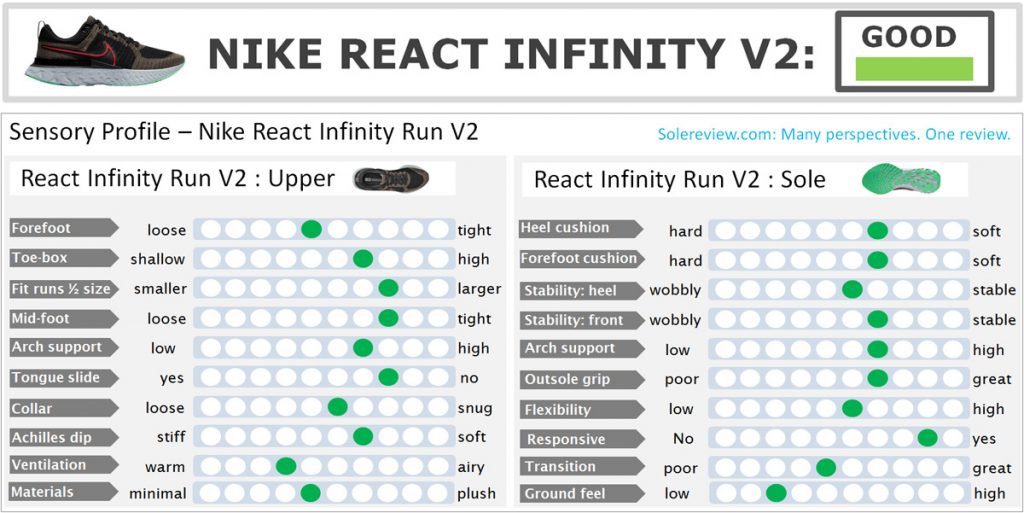INTRODUCTION
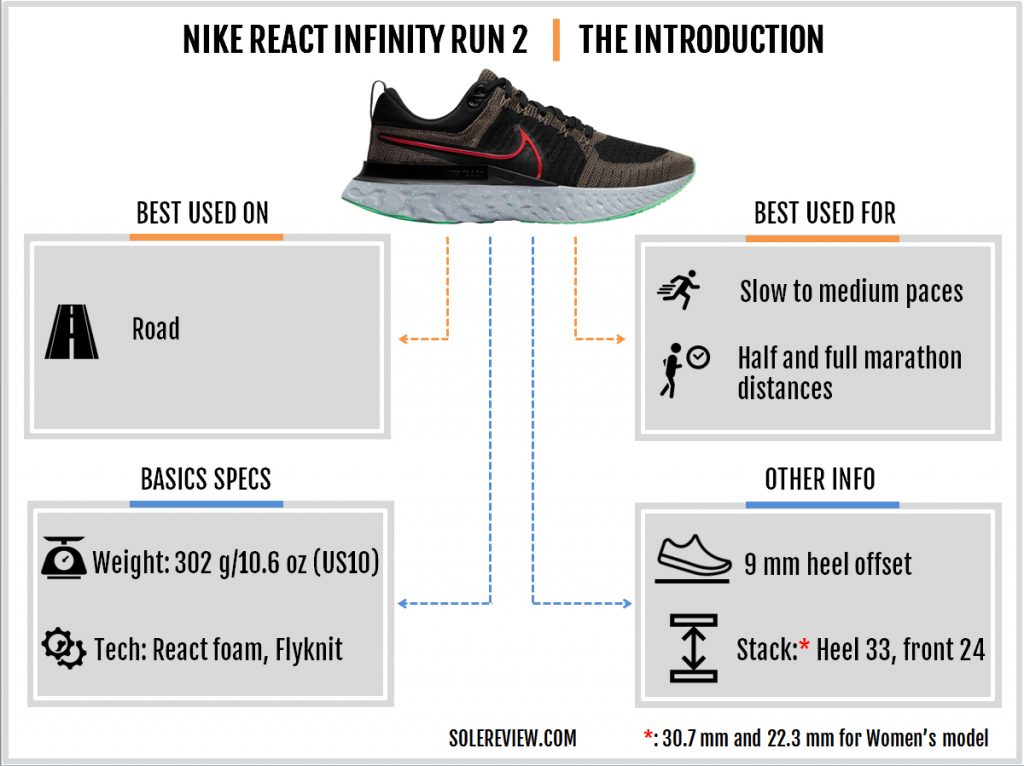
Before Nike’s ZoomX foam became the new gold standard for all things cushy and bouncy, there was Nike React.
Our first encounter with Nike’s then-new foam was on the Epic React – a running shoe that wasn’t perfect, but its high-volume midsole held a lot of promise. Considering how most of Nike’s footwear models felt long in the tooth not very long ago, the React was just the shot in the arm that Nike needed.
For the most part, Nike React has lived up to its promise. React has proved itself to be a dependable midsole material and crowd-pleaser. It is a reliable cushioning platform that blends ride comfort with versatility.
Nike React also occupies an unusual segment within midsole foams. It possesses neither the bouncy resilience of adidas Boost, nor the superior springy softness of Nike ZoomX.
If someone were to draw a straight line (representing the cushioning character) with the regular EVA foam on one end and Nike ZoomX at the other, the React would occupy a place in the center. It’s not the most responsive foam, nor is it the softest or lightest.
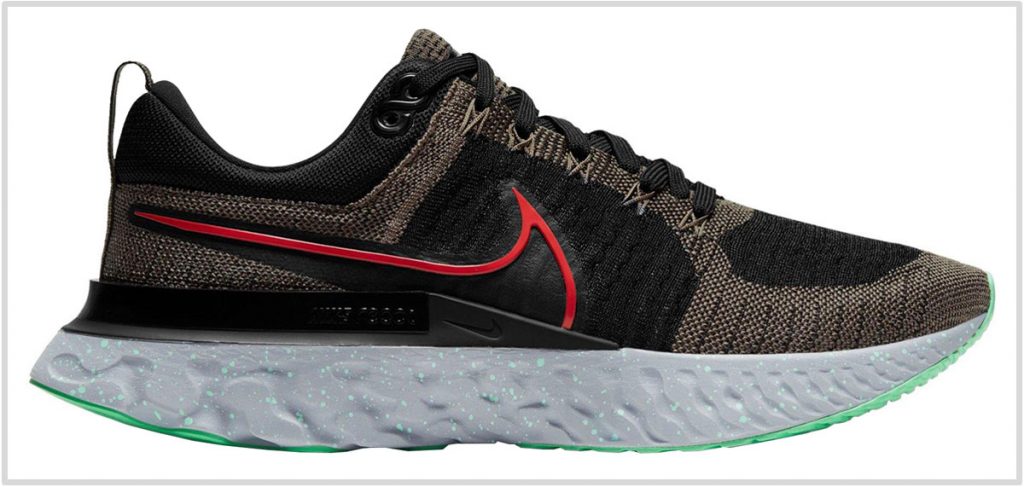
It is this foam that is the centerpiece of the React Infinity Run 2. Like the version preceding it, the V2 is a cushioned running shoe that can wear several hats, depending on the occasion.
Those ‘hats’ could be either being a daily trainer at varying paces, or filling in as a high-mileage cruiser when the occasion demands.
In this review, readers will notice that when compared to the Infinity React V1 write-up, we have a different opinion of the ride character – even though the midsole and outsole haven’t changed.
That’s because the cushioning benchmark has evolved over the past year.
Till the time the ZoomX Invincible Run came along, this 100% React foam-based shoe was Nike’s max-cushioning ambassador. This year, things have changed. When compared to the Invincible, the React Infinity no longer feels like a ‘max-cushion’ running shoe.
Context, as they say, is everything.
THE NIKE REACT INFINITY RUN 2 vs. V1
Nike usually uses the same midsole and outsole design for two successive versions. Apply that rationale, and the React Infinity 2 should have identical underpinnings as the V1. And it does.
With that comes a borderline identical ride with its strengths and flaws – an area which we’ll address in the next section.
The upper, however, is a different story. The heel no longer has a sock-type entry, but a proper heel and tongue set-up. On paper, that seems like an improvement. While it is better than the V1 in a few ways, the scope for improvement remains.
On the fit side, the toe-box has more room, whereas the midfoot offers better fit security over the former model. The heel fit is better, though that (also) comes attached with a caveat.
THE RIDE EXPERIENCE
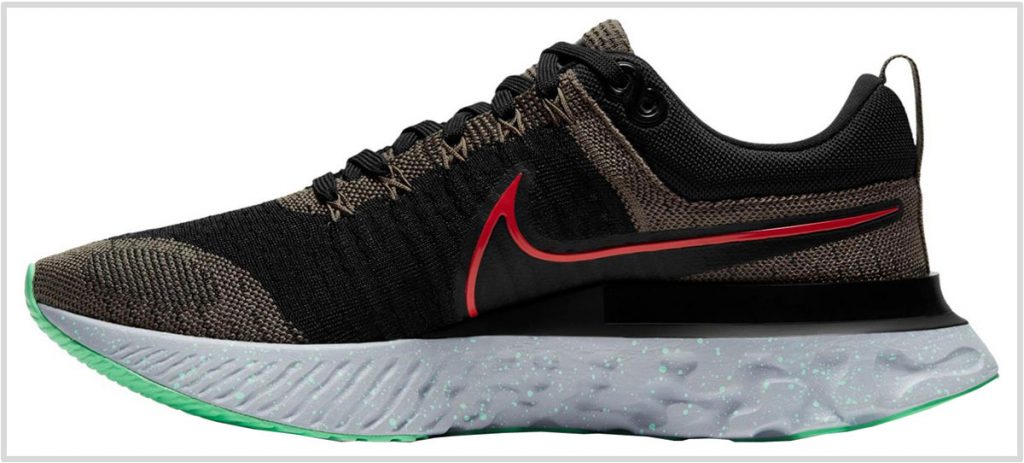
Before diving deep into the React Infinity Run’s ride quality, it’s worth bringing up the latter’s origin story.
The Epic React was the precursor to the Infinity – Nike’s first shoe with an all-React foam midsole. Back then, the Epic was the mantlepiece of Nike’s running shoe assortment, since the Vaporfly (in 2018) was exactly what it sounded like – Vaporware that was very hard to acquire.
As noted in our detailed review of the Epic React, we liked how the React midsole felt under the foot. There were some shortcomings, like how the synthetic rubber-based compound reacted adversely to cold weather.
There were some teething issues on the upper like the Achilles-biting heel, but as a whole, the Epic React was a solid first act.
The React Infinity V1 succeeded the Epic and brought with it additional features. The midsole designed was tweaked to accommodate multiple strips of outsole rubber. Also, the plastic clip was made larger and placed atop the midsole instead of being flush with it.
Last year, signs were afoot that the Nike Structure 22 would be the last in its line. In other words, Nike’s traditional ‘stability’ shoes with a medial post were to be retired. (The Structure 23 is here, but is nothing like the 22.)
When advertising the React Infinity V1, Nike made direct comparisons with the Structure 22 and claimed that runners who wore the React Infinity were less likely to be injured when compared to the Structure.
To support that claim, the Infinity React used a plastic (and rubber) clip over the midsole that extended on either side. Though it was meant to ‘guide’ the foot through the gait cycle, we felt that the whole experience was intrusive.
While most of the rim that extends under the arch is made of flexible rubber, it’s hard to shake away the feeling that something was pushing against the arch.
It doesn’t help that the midsole has a narrow waist, so the weight loading is confined to a small area.
The rims aren’t a source of discomfort, but rather an unnecessary feature the shoe could do without. It would have been a better idea to a) make the rim flush with the midsole like the Epic React, or b) Follow the design template of the ZoomX Invincible Run.
Barring the under-arch clip, the React midsole delivers a cushioned ride experience that also proves to be versatile. The thick foam stack (33 mm rear, 24 mm front) packs a lot of underfoot comfort for daily training without excessive softness.
React foam-based shoes have always occupied the ‘medium soft’ rung of the cushioning ladder. Given the changed circumstances, Solereview no longer views the Infinity React as a max-cushioning shoe – not even on the lines of the New Balance 1080 V11.
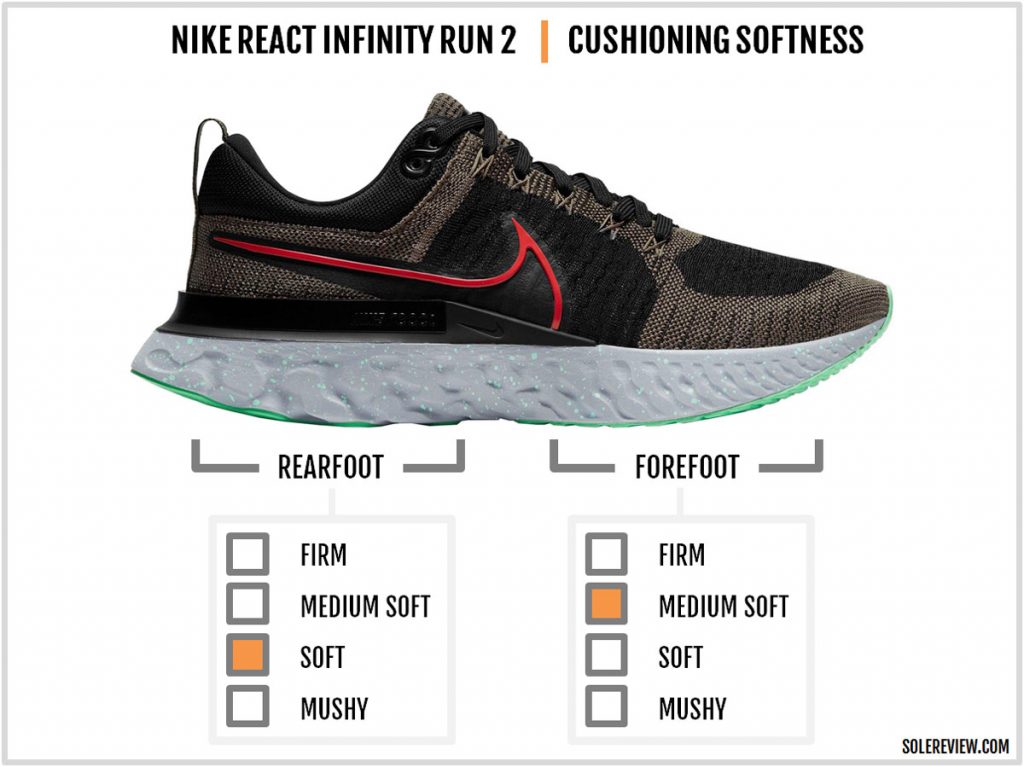
The insole thickness (and the lack thereof) also plays into the ride character. The footbed is a thin sheet of foam that’s glued to the lasting. Thus, not much separates the foot from the midsole, so the shoe lacks the step-in layer of softness that’s found in most shoes.
Therefore, the React midsole exhibits its best behavior when on the move. At slower paces (6 min/km, 10 min/mile), the rubbery foam responds with a muted rebound that translates into ride comfort.
At higher paces (4:30 min/km, 7 min/mile), the transitions do not feel labored; while the Infinity React isn’t the best shoe for faster runs, it doesn’t feel like running on molasses either.
As a result, the midsole manages to achieve a sensible balance between long-distance capabilities and pace-friendly transitions.
The midsole is single density with a grooved outsole geometry and beveled heel, and that bodes well for the traction and transition delivery. Unlike the ZoomX Invincible, the midsole doesn’t feel squishy under high cadence runs.
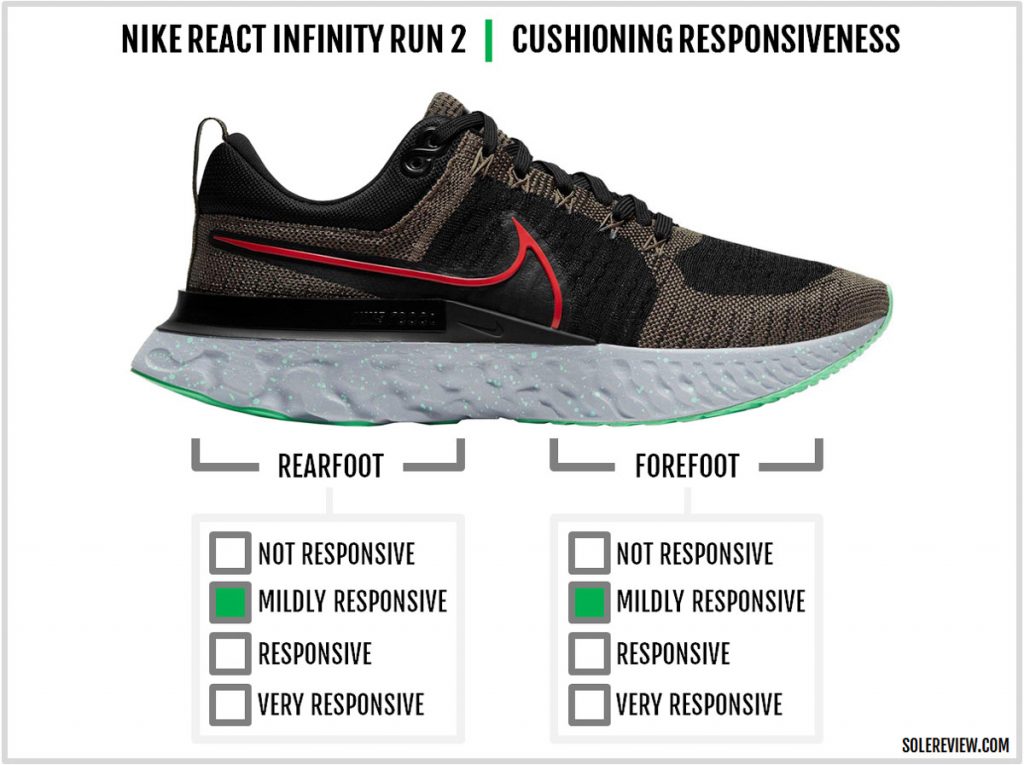
The ‘responsiveness’ of a shoe is purely contextual. How responsive a shoe is (or not) depends on the existing benchmarks, so a shoe that we define as ‘super soft’ or ‘very responsive’ in one year may not be judged by the same standards in the following year.
This shoe is a good example. Our sensory scorecard for the React Infinity V1 placed the cushioning on the softest side of the spectrum, but for the V2, we’ve moved the slider towards the left. We’ve done the same with midsole stability too. The new upper offers better fit security while having a positive effect on the ride stability.
Eagle-eyed readers would have noticed the discrepancy, so we thought it better to offer a clarification.
The rearfoot stability is as much about the upper fit as it concerns the midsole. While there’s a bit of downwards travel (of the foot) over the React foam base, the padded heel grips the foot securely. The Flywire-equipped upper also does a better job at securing the midfoot than the V1.
Forefoot stability wasn’t a problem with the V1 due to the wide midsole flare, and it isn’t a concern here either. The wide forefoot creates a planted foundation for cushioned landings and turnovers alike.
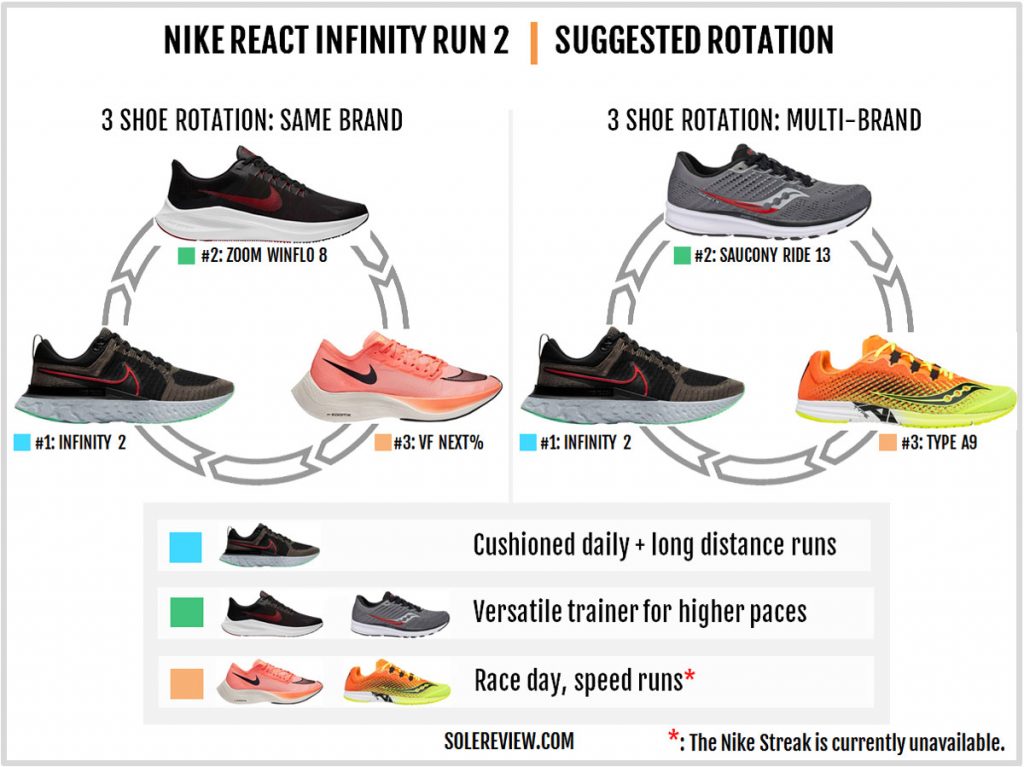
In recent times, recommending a three Nike shoe rotation has become a bit of a struggle.
For example, since the React Infinity does well as a daily trainer and a long-distance shoe, does it make sense, if at all, to get a true max-cushioned (and faster) shoe like the Vaporfly Next%?
Of course, we can, but the question is: does it add rotational value? Nike’s recent descent (or ascent?) into cushioning softness also complicates matters.
For example, the soft rear half of the Pegasus 37 (and presumably, 38) feels nothing like the do-it-all Pegasus 34, 35, or the 36. We don’t see a Zoom Streak racer either.
Our imperfect recommendation would be to add either the Zoom Span or Winflo 8 for a better ground feel (and hence, speed), plus the ZoomX Invincible Run for its ultra-plush ride. Either that, or we can also substitute the Span or Winflo 8 with the Structure 23. The Structure 23 feels ‘peppier’ than the Infinity and is more fun at higher speeds.
Exploring non-Nike alternatives yield better results. The Saucony Type A9 is an excellent road racing flat, and the Saucony Ride 13 is the perfect daily trainer with a little more performance range. Its firm ride gives it better speed-run capabilities than the React.
If the Saucony Ride 13’s muted ride character doesn’t seem fun enough, may we suggest the Reebok Floatride Run Fast?
IS THE NIKE REACT INFINITY V2 DURABLE?
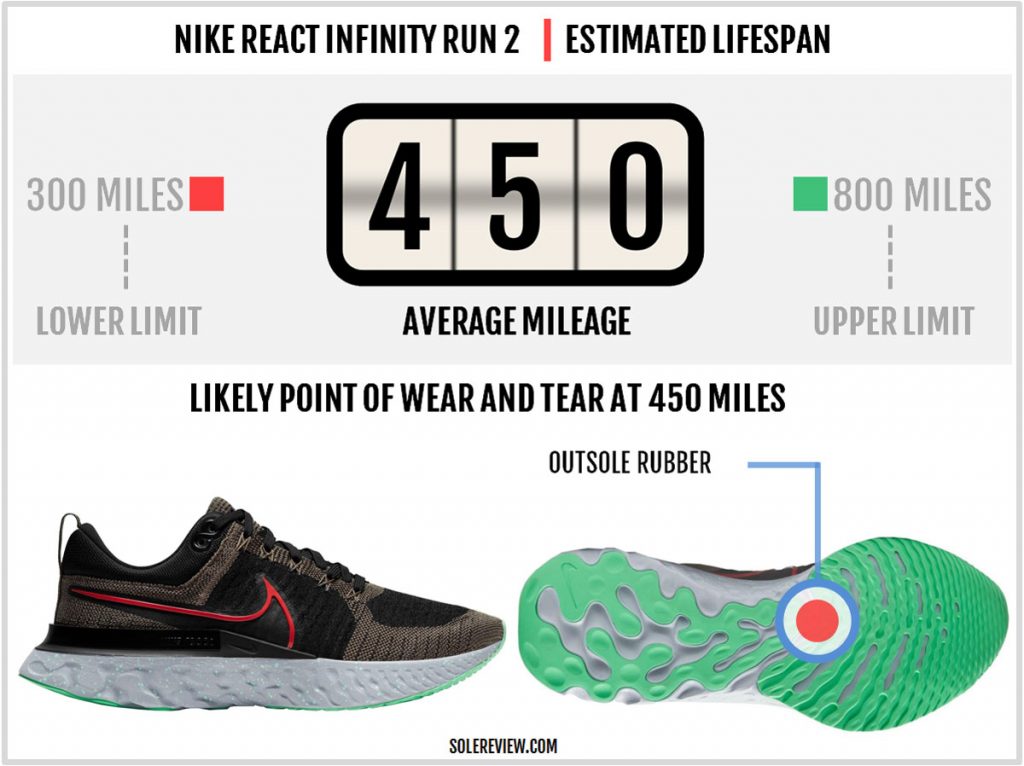
Segmented outsole designs fare very well on long-term durability, and we haven’t received adverse reader feedback on the Infinity V1. Since the V2 shares the same midsole and outsole, the lifespan will be similar.
Based on initial impressions, the thick Flyknit upper feels durable. If any of our readers feel otherwise, a user-submitted review (with images) will help immensely. Here’s the page for sending us a detailed review.
THE UPPER DESIGN AND FIT
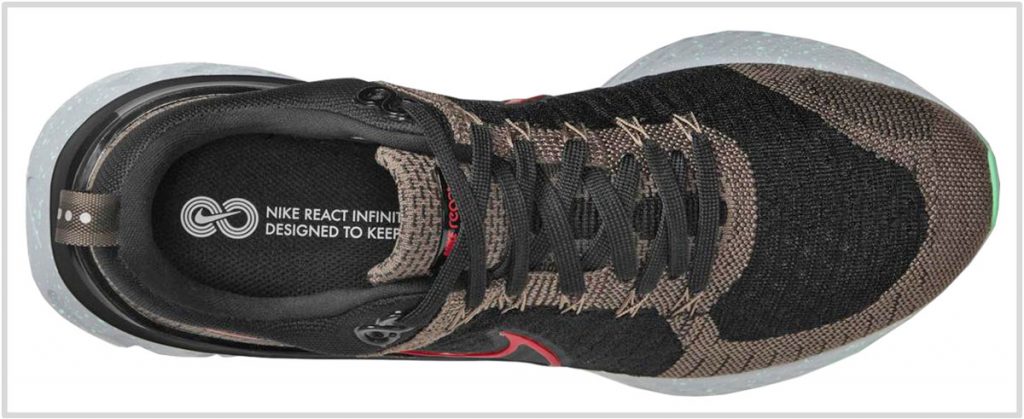
The midsole and outsole may not have changed, but the new upper is chock-a-block with noteworthy updates.
The React Infinity 2 introduces a conventional entry system together with a Flywire-equipped midfoot. Runners who found the V1’s sock-like upper difficult to enter will discover the new upper to be (more) amenable.
From an overall fit (and sizing) perspective, the Infinity V2 differs from the V1 in a significant way. Whereas the Infinity V1’s fit felt relatively uniform from the heel to toe, the V2 has its share of secure and easy spots.
For example, the midfoot fit undergoes a complete transformation. To compensate for the inherent grip of the V1’s sock-like entry, Nike has modified the lacing design by bringing in a Flywire cinching system.
To be clear – we’re not saying that the React Infinity V1’s heel fit was better. In fact, the heel fit was sloppier than this year’s model. This year’s version has a traditional heel design that does a better job at securing the heel.
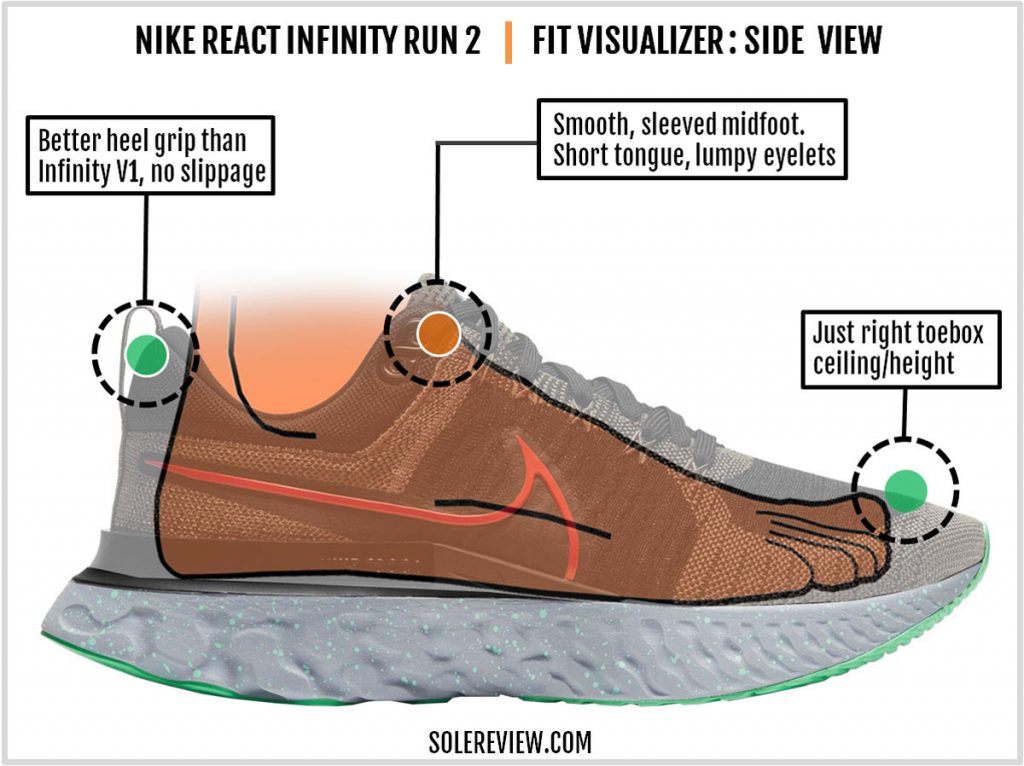
That being said, the heel fit isn’t perfect. To rephrase that – the ‘sensory’ aspect of the heel fit needs some work. This has nothing to do with the heel though; the short tongue is to blame instead.
Nike’s tongue lengths are temperamental – at times, it’s too long. Here, it’s too short.
Nike’s design motivations are unclear, but the tongue isn’t as long as it needs to be. Consequently, the tongue flap doesn’t rest plushly over the instep, and that affects how the heel fit feels.
This is purely a sensory issue though; there’s no heel slippage.
The midfoot fit is an improvement over the last model, that too by leaps and bounds. The Flywire cords run through either side of the knit upper and connect to the lacing; this improves the Infinity’s midfoot grip.
The lacing density adds security to the fit too, thanks to the higher count of lacing rows. With a separate tongue, the laces are a lot more effective than those on the Infinity V1.
The midsole has a widely flared forefoot and a slimmer midfoot, so that, too, influences the fit. The improved midfoot fit translates into better midsole stability as well.
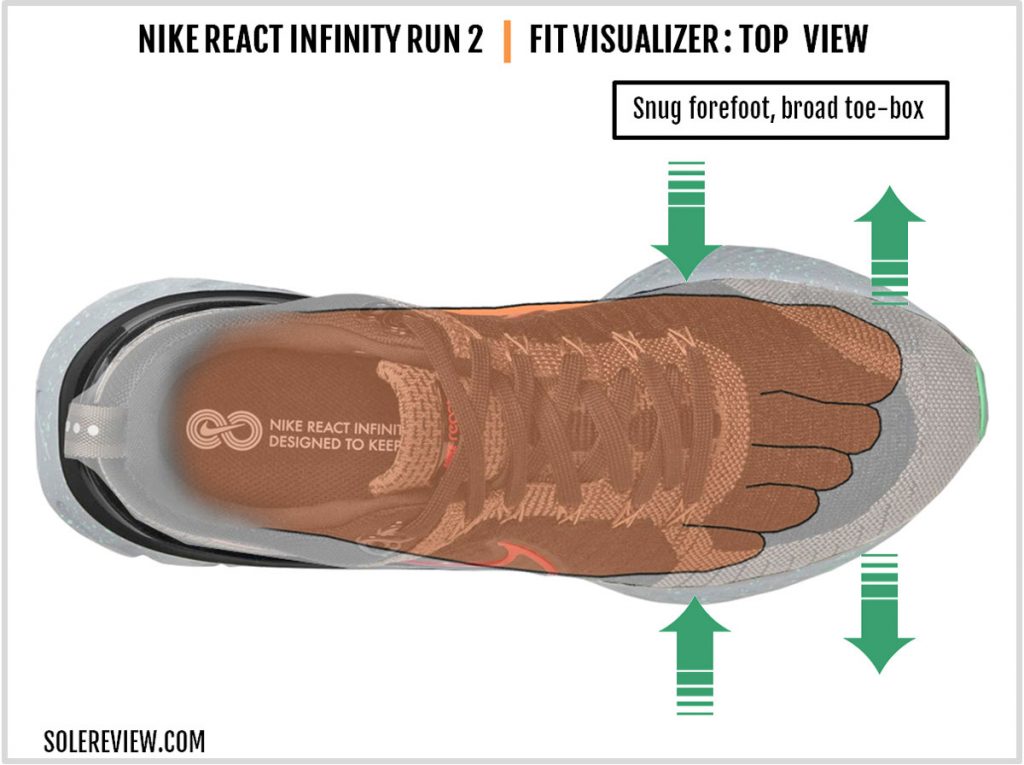
The forefoot feels wider not because of the mesh change (which takes place, too), but also due to the placement of the lacing rows. The first row of lacing is set farther from the tip as compared to the V1.
In short, a larger section of the forefoot is unencumbered by the lacing system. With this change, the toes now have more room to splay. Though the Infinity runs true to size, the upper has a longish fit due to the fit contrast between the roomier forefoot and snugger midfoot.
This is what we meant when we said that the React Infinity has different ‘zones’ of fit.
The snugness level varies depending on which part of the shoe we’re referring to. It’s snuggest at the center, which isn’t surprising given the liberal application of Flywire cords. That’s followed by the padded heel, and finally, we have the easygoing toe-box fit.
While we’re at it, the last two eyelets deserve a special mention. The holes are reinforced with a thick plastic retainer. We assume that Nike included these to increase the tear strength. To that, we say: good intentions marred with poor execution.
These eyelets feel lumpy and feel out of place on the knit upper. Too much of a good thing is bad; there’s too much structure concentrated in a small area – this is where the thick plastic and two layers of mesh meet.
The ventilation levels are ok. The Flyknit mesh is thick, so the air doesn’t pass as freely as it would inside a conventional upper.
Reflectivity is often given a miss on knit uppers, but that isn’t so here. The heel pull tab has reflective printed details, thus providing visibility in low-light conditions.
PROS AND CONS
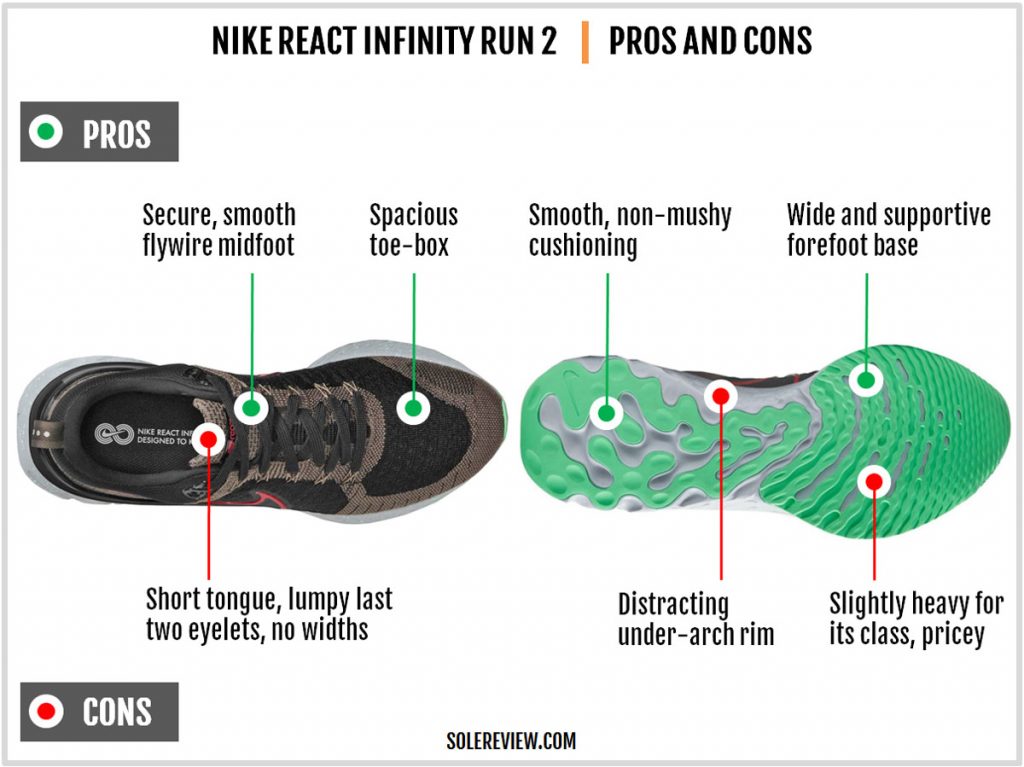
The $160 retail price of the React Infinity needs to be addressed. The price was somewhat justified when React was new. Even then, the 2018 Epic React was ‘only’ $150.
In 2021, the React foam is a second-tier cushioning system after ZoomX, so the React Infinity is over-priced and not the best use of $160.
Looking at the competition (Reebok Floatride, adidas Boost, Saucony PB), shoes with superior cushioning platforms sell for equal or lower prices. React is now what Lunarlon used to be 8 years ago. It shows up in different tiers of product, be it the Vomero 15 or the relatively affordable React Miler 2.
If not for the sticker price, the React Infinity 2 does many things well. The midsole is cushioned and somewhat versatile (meaning okay-ish for faster runs), and the improved midfoot and heel fit addresses some of the stability concerns we had with the React Infinity V1.
Among its flaws, we’d list the intrusive under-arch rim, short tongue, and lumpy eyelets.
THE NIKE INFINITY REACT V2 vs. REACT MILER V2
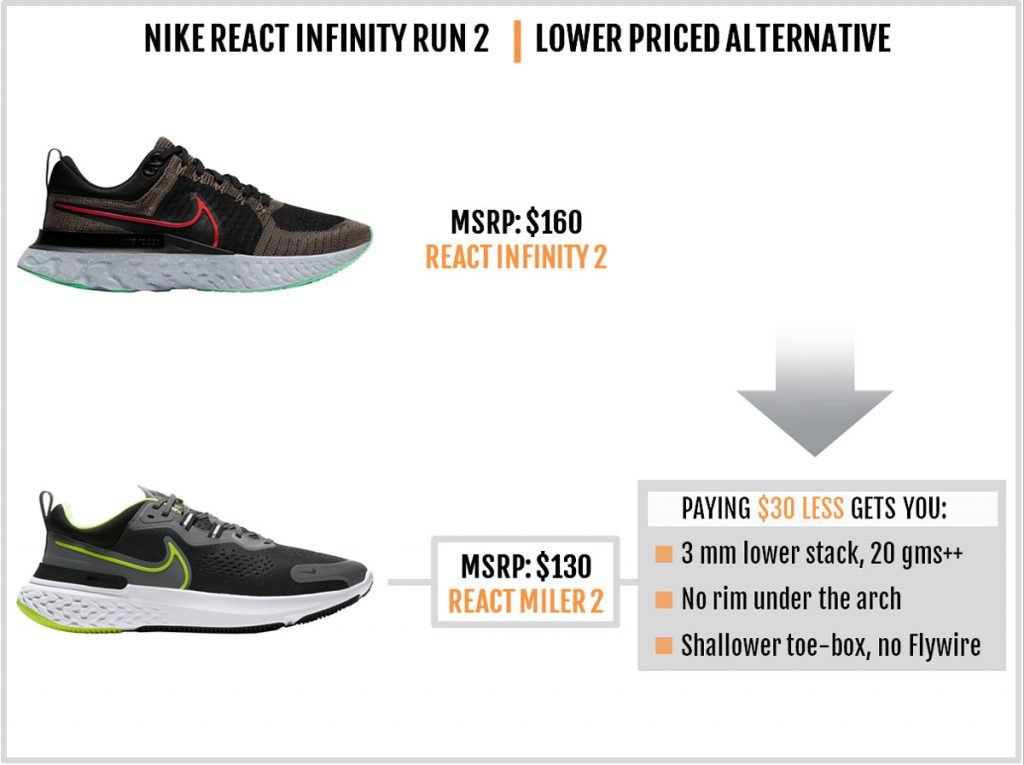
The React Miler 2 possesses more Pegasus-like traits than the Pegasus 37. In other words, it’s got a smooth and comfortable ride that’s not too soft.
Compared to the Infinity, the Miler’s React midsole stack is 3 mm lower. The lower profile midsole increases the versatility, making the Miler 2 more suitable for quicker paces.
The toe-box of the React Miler 2’s is noticeably shallower than the Infinity. In lieu, the midsole doesn’t have the intrusive clip under the arch. It’s a worthy substitute for the React Infinity, that too at a lower price.
SHOES SIMILAR TO THE NIKE INFINITY REACT V2
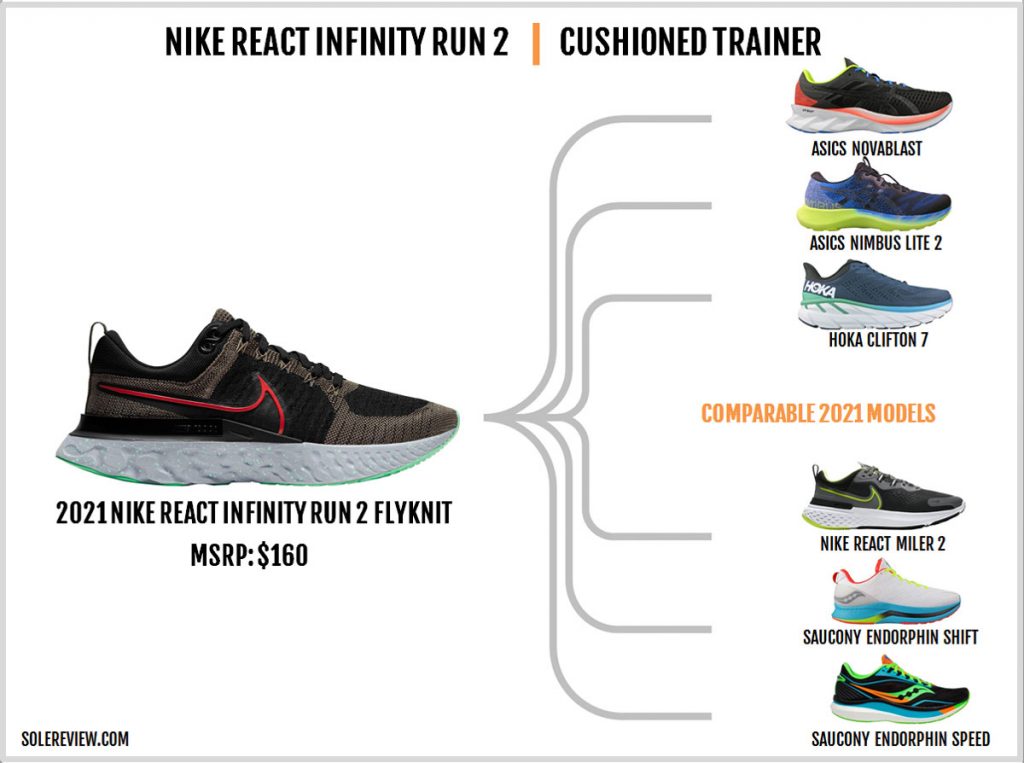
Besides the Nike React Miler 2, several others compete with the React Infinity 2 – conceptually speaking, that is.
The Asics Novablast is a fun shoe with lots of distance and transition-friendly comfort, and so is the Hoka Clifton 7. Due to its higher-volume midsole, the 5 mm offset Clifton 7 provides deeper cushioning than the React Infinity.
There’s another shoe from Asics worth a second look. That would be the Asics Nimbus Lite 2. The ride delivery feels cushioned without coming across as clunky; it’s an under-rated shoe with a do-it-all persona.
We’ll throw in a couple of shoes from Saucony here.
While one should take a look at the firm yet cushioned Endorphin Shift, the plate-equipped Endorphin Speed is an interesting option.
The Peba foam midsole has practically all the cushioning that one needs (and wants), and a Nylon plate keeps things snappy – a ride trait that is absent on the React Infinity.
By the way, the Infinity and Endorphin are priced identically. See? That’s what $160 can also buy – a better running shoe.
Do you own this shoe? Improve this review by sharing your insights – submit a review here.

